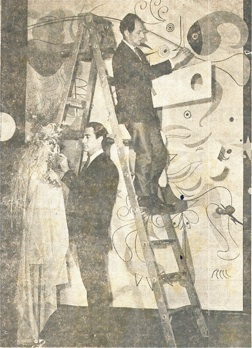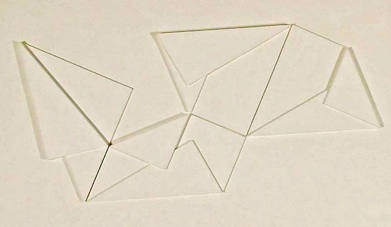California and Bristol
1965-83
Later in 1965 Canney was appointed visiting Gallery Director and Lecturer at the University of California, Santa Barbara, spending two years there. He was stimulated by West Coast art and artists, many of whom he met. While there, he was involved in a number of exhibitions, including a major exhibition of Dada and Surrealism, in collaboration with the Santa Barbara Museum and Art Gallery. His wife and son remained in Cornwall, the family having moved from Newlyn Art Gallery to Sancreed House, where they rented part of the building from architect turned artist John Miller and sculptor Michael Truscott.
‘Seeing Cornwall and Cornish art from California was a valuable experience,’ Canney recalled, ‘and it put events and personalities there in perspective. However, Cornwall was not far away, as I found when I visited the old gold-mining communities in Northern California, and saw the graves of· Cornish exiles from such places as Redruth and St Just who never managed to return home.’
Canney was invited by Paul Feiler to join the staff of the West of England College of Art (subsequently part of Bristol Polytechnic, now the University of the West of England) in 1966, together with West Coast painter Hassel Smith, whom he had known both in Cornwall and in California. He remained at Bristol, where he became principal lecturer in painting in the department of fine art, leaving finally in April 1983.
During Canney’s time at Bristol, many painters and sculptors from London and elsewhere visited. ‘As a result, I was able to meet a number of older artists whom I had never met before, and an entirely new generation of young painters and sculptors who undoubtedly exerted an influence on my thinking and my work,’ he wrote. ‘My paintings and reliefs of the early 1970s onwards are broadly related to the Constructivist tradition and rely upon simple principles [elaborated in the Newlyn catalogue of 1983, “Michael Canney – Recent Works”, in which the work constructs itself from itself. Both paintings and reliefs proceed initially from the square, which is then subjected to various processes, such as cutting, folding, overlapping, inversion and rearrangement of the parts, and so on. These divisions of the original square format are usually oblique and dynamic, precisely measured, and often rely upon certain classic proportions or numerical systems. The essential principle is that the painting or relief is ultimately constructed from the original material alone, and that nothing extraneous is added. In this limitation lies the creative challenge.’
In 1978 Canney collaborated with Patrick and Delia Heron on a travelling exhibition, ‘Norman and Alethea Garstin – Two Impressionists’, researching and writing the artists’ biographies. (Norman Garstin was a distinguished member of the Early Newlyn School, and his daughter Alethea, a gifted painter in the manner of Vuillard.)
In the early 1980s, following on his ‘white relief’ phase, Canney started to use a paint type “which would transform the variety and appearance of his pictures”, in the words of Robert Miller, who wrote the introduction to the catalogue for a posthumous Fine Art Society exhibition in 2007. “His discovery and experimentation with alkyd allowed his vision and thoughts to come to fruition in a burst of creativity… Alkyd, or alkyd oil paint, contains a resin which means that the medium dries quickly, or more accurately ‘sets’ or hardens. This happens in a matter of hours and allows blocks of colour to be laid down adjacent to each other without any danger of ‘run’ or mixing.” The earliest dated works by Canney using this medium are from 1981.
Changing perspectives
Above: ‘Stretchfold III’, 1985
Right, from top: Michael Canney (on ladder) creating murals for a surrealist-themed ball at Santa Barbara, University of California, 1966;
‘One-Two’, 1965
From West Coast to West Country


